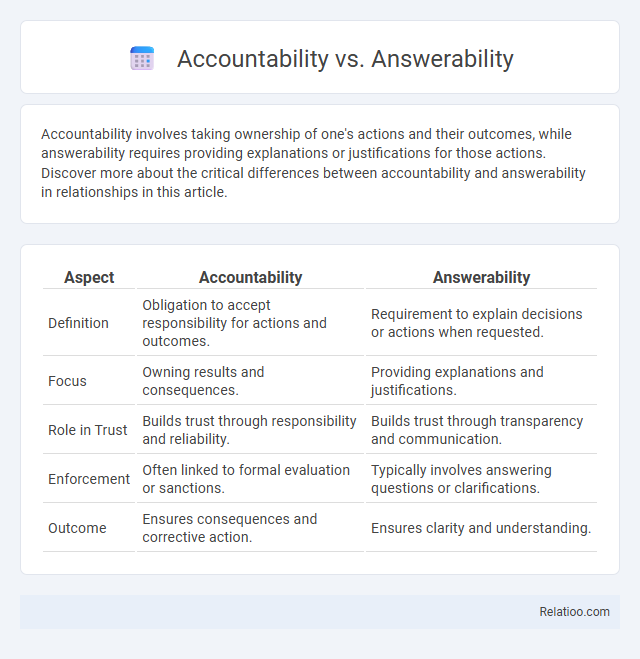Accountability involves taking ownership of one's actions and their outcomes, while answerability requires providing explanations or justifications for those actions. Discover more about the critical differences between accountability and answerability in relationships in this article.
Table of Comparison
| Aspect | Accountability | Answerability |
|---|---|---|
| Definition | Obligation to accept responsibility for actions and outcomes. | Requirement to explain decisions or actions when requested. |
| Focus | Owning results and consequences. | Providing explanations and justifications. |
| Role in Trust | Builds trust through responsibility and reliability. | Builds trust through transparency and communication. |
| Enforcement | Often linked to formal evaluation or sanctions. | Typically involves answering questions or clarifications. |
| Outcome | Ensures consequences and corrective action. | Ensures clarity and understanding. |
Understanding Accountability and Answerability
Accountability involves being responsible for actions and their outcomes, ensuring that duties are fulfilled according to established standards. Answerability refers to the obligation to explain or justify decisions and behaviors to stakeholders or authorities. Understanding accountability and answerability highlights the relationship between responsibility for results and the transparency or communication required to support those responsibilities.
Key Differences Between Accountability and Answerability
Accountability involves being responsible for outcomes and bearing the consequences of actions, whereas answerability focuses on providing explanations or justifications for decisions made. Your role in accountability means accepting both praise and blame for results, while answerability centers on the obligation to respond to inquiries or demands for information. The key difference lies in accountability's emphasis on ownership of outcomes, contrasted with answerability's emphasis on transparency and explanation.
The Importance of Accountability in Organizations
Accountability in organizations ensures that individuals and teams are held responsible for their actions and decisions, promoting transparency and trust. Unlike answerability, which involves explaining or justifying actions, accountability emphasizes ownership and the obligation to deliver results. Prioritizing accountability enhances organizational performance, fosters ethical behavior, and drives continuous improvement.
The Role of Answerability in Professional Settings
Answerability in professional settings involves the obligation to explain decisions and actions to stakeholders, ensuring transparency and trust within organizations. Your role in providing clear justifications fosters accountability, which encompasses the responsibility to meet expectations and face consequences for outcomes. Understanding the distinction between answerability and accountability helps improve communication, performance, and ethical standards in the workplace.
Historical Perspectives on Accountability and Answerability
Historical perspectives on accountability trace back to ancient governance systems where rulers were held responsible for their actions to maintain social order and legitimacy. Answerability emerged as a fundamental concept in legal and administrative contexts, emphasizing the obligation of individuals and officials to provide explanations for their decisions and behaviors. Your understanding of accountability and answerability deepens when recognizing how these concepts evolved to balance authority with transparency and responsibility in various cultural and institutional frameworks.
Benefits of Fostering Accountability Over Answerability
Fostering accountability over answerability enhances your team's ownership and commitment to results, driving sustained performance improvements and proactive problem-solving. Accountability encourages individuals to take responsibility for outcomes and learn from mistakes, promoting a culture of trust and continuous growth. Emphasizing accountability also reduces micromanagement, empowering employees to make decisions aligned with organizational goals efficiently.
Challenges in Distinguishing Accountability and Answerability
Distinguishing between accountability and answerability presents challenges due to their overlapping roles in responsibility and transparency. Accountability emphasizes the obligation to justify actions and face consequences, while answerability centers on providing explanations or information about decisions made. Clear differentiation is complicated by organizational structures where roles may blend, causing confusion in enforcing responsibility and assessing performance.
Real-World Examples: Accountability vs Answerability
Accountability involves taking responsibility for outcomes and being subject to consequences, such as a CEO held accountable for a company's financial performance. Answerability requires providing explanations or justifications for decisions, exemplified by a government official answering questions during a parliamentary inquiry. In real-world scenarios, accountability ensures enforcement of consequences, while answerability emphasizes transparency and responsiveness without necessarily involving sanctions.
Enhancing Accountability and Answerability in Teams
Enhancing accountability and answerability in teams requires clear role definitions and transparent communication channels to ensure each member understands their responsibilities and the expectations for reporting outcomes. Implementing regular progress tracking and feedback loops fosters a culture where team members are both responsible for their tasks and answerable for their decisions, driving performance and trust. Leveraging project management tools like Jira or Asana enables real-time monitoring and accountability, empowering teams to meet deadlines and deliver consistent results.
Best Practices for Balancing Accountability and Answerability
Balancing accountability and answerability requires clear communication of roles and expectations to ensure you are both responsible for outcomes and capable of explaining decisions. Establish regular check-ins and transparent reporting mechanisms to promote trust and encourage proactive problem-solving. Implementing feedback loops and emphasizing personal ownership fosters a culture where accountability aligns with open answerability for continuous improvement.

Infographic: Accountability vs Answerability
 relatioo.com
relatioo.com